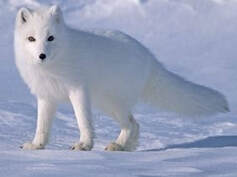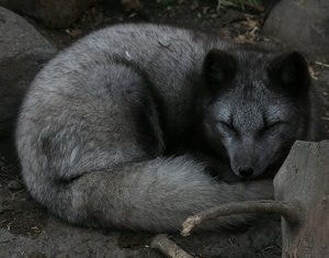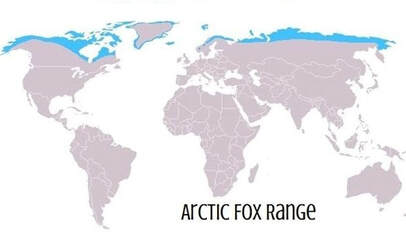Arctic Fox
|
Description: The Arctic fox is an amazingly hardy little fox that can survive in temperatures down to -58 degrees (F) because of it's thick, double layered coat. It's short ears, muzzle, and furry pads on it's feet help it adapt to it's harsh winter climate. During the summer, you may see it's coat change to a more blue-ish gray hue, while staying perfectly white in the winter. This helps camouflage it against the snowy landscape and effectively hunt rodents, fish, eggs, carrion, and even birds.
|
|
To stay warm and have protection from predators, they live in burrows. The fox has a thick tail that helps it balance, much like a cat. Like the Red Fox, they pounce on pray buried beneath the snow, and have extreme accuracy despite their smaller ears.
In the wild, it only has an average lifespan of 3-6 years, however in captivity it has an average of 12-14. Weighing in a range of 6-17 pounds, most people don't realize the majority of their body is fur. During the summer they have a darker coat (pictured below) and during winter a white coat (left). |
|
Diet: In the wild, they would be omnivores, eating mice, plants, insects, and fruits and veggies if possible, so their diet must reflect this in captivity. They do not have specific diet restrictions in comparison to other foxes, so you can read more about a good diet on the 'Diet & Adopting' page. Since they generally live in colder climates, their diet would consist mostly of meat the majority of the year when they eat mice and small rodents. When hunting in the wild, it will pounce through the snow to catch it's victim.
As A Pet: The biggest thing most owners will tell you is about the smell. Arctic Foxes secrete odor from glands under their fur and also have extremely odorous urine that has been described as similar to the spray a skunk would emit. |
They also have been described to be temperamental, stubborn, and hard to train. But, they can be trained and cared for, as I have seen multiple accounts of people having them as pets. They tend to do best in an outdoor enclosure, as they are destructive like Red Foxes, but still need to be taken out and given plenty of attention. It is good to remember that foxes need more human interaction than dogs, since they instinctively tend to be fearful of humans. Like most foxes, they can tend to revert back to their wild instincts if not constantly interacted with. Daily interaction is a must with all pet foxes.
Arctics should be adopted early, otherwise multiple issues can occur, such as fearfulness of the new owner, improper socialization, etc. I have seen accounts of this species of fox getting along extremely well with other dogs, and when out of the enclosure being kept in a domestic dog-like setting.
Arctics should be adopted early, otherwise multiple issues can occur, such as fearfulness of the new owner, improper socialization, etc. I have seen accounts of this species of fox getting along extremely well with other dogs, and when out of the enclosure being kept in a domestic dog-like setting.
Sources accessed and modified: http://animals.nationalgeographic.com





